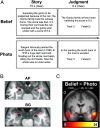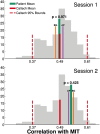Amygdala lesions do not compromise the cortical network for false-belief reasoning
- PMID: 25825732
- PMCID: PMC4403179
- DOI: 10.1073/pnas.1422679112
Amygdala lesions do not compromise the cortical network for false-belief reasoning
Abstract
The amygdala plays an integral role in human social cognition and behavior, with clear links to emotion recognition, trust judgments, anthropomorphization, and psychiatric disorders ranging from social phobia to autism. A central feature of human social cognition is a theory-of-mind (ToM) that enables the representation other people's mental states as distinct from one's own. Numerous neuroimaging studies of the best studied use of ToM--false-belief reasoning--suggest that it relies on a specific cortical network; moreover, the amygdala is structurally and functionally connected with many components of this cortical network. It remains unknown whether the cortical implementation of any form of ToM depends on amygdala function. Here we investigated this question directly by conducting functional MRI on two patients with rare bilateral amygdala lesions while they performed a neuroimaging protocol standardized for measuring cortical activity associated with false-belief reasoning. We compared patient responses with those of two healthy comparison groups that included 480 adults. Based on both univariate and multivariate comparisons, neither patient showed any evidence of atypical cortical activity or any evidence of atypical behavioral performance; moreover, this pattern of typical cortical and behavioral response was replicated for both patients in a follow-up session. These findings argue that the amygdala is not necessary for the cortical implementation of ToM in adulthood and suggest a reevaluation of the role of the amygdala and its cortical interactions in human social cognition.
Keywords: amygdala; fMRI; false-belief; lesions; theory-of-mind.
Conflict of interest statement
The authors declare no conflict of interest.
Figures



References
-
- Brothers L. The social brain: A project for integrating primate behavior and neurophysiology in a new domain. Concepts Neurosci. 1990;1:27–51.
-
- Frith CD, Frith U. Social cognition in humans. Curr Biol. 2007;17(16):R724–R732. - PubMed
-
- Whalen PJ, Phelps EA. The Human Amygdala. Guilford Press; New York: 2009.
-
- Gothard KM, Battaglia FP, Erickson CA, Spitler KM, Amaral DG. Neural responses to facial expression and face identity in the monkey amygdala. J Neurophysiol. 2007;97(2):1671–1683. - PubMed
Publication types
MeSH terms
LinkOut - more resources
Full Text Sources
Other Literature Sources

